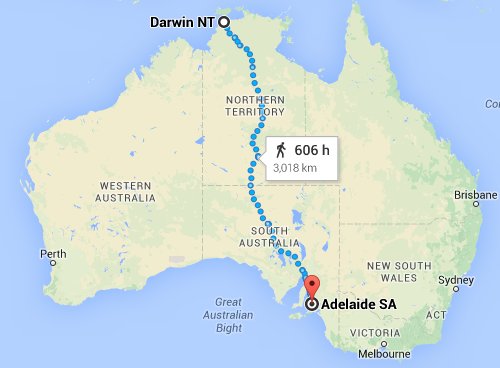Cycling from Darwin to Adelaide
On the Stuart Highway, 3000 Km, paved
I have never cycled this route. It crosses vast sparsely
inhabited areas of "outback" Australian semi-desert. I have
worked in this region and it can be nice but I choose not to
spend a month cycling across it.
But many cyclists do ride this route, so here is
some vital information.
The best time to ride it is late May to mid
September. From November through to March it can be extremely
hot, greater than 40 C in the shade (which does not exist).
You should plan to carry plenty of water as you may ride all day
without passing a service point where you can get water.
Francois rode this route from October 19 to
November 18 and made these comments
- there is a perfect application for mobile phones called
"Wikicamps" it's a community made map with all roadhouses,
campsites and major and minor rest areas and all the useful
information about all them (distances, available services,
prices, review, ...) for all Australia (and USA, NZ &
UK)
- there is no Telstra (mobile phone, mobile internet)
coverage in the outback, only close to the roadhouses (which
is enough !)
- absolutely all roadhouses have showers, most of them have
swimming pool !
- the road train drivers are generally very professional
and respectful of cyclists, I never felt in danger. There
are many less trucks in Australia than in other countries !
(But take note, these trucks have
3 trailers and can be dangerous. Cyclists have been
killed, so always give them plenty of clearance and
respect)
- there were many tourist vans on the road, some of those
drivers are more dangerous !!
- I was offered water and food many times on rest areas by
tourists.
- there is a 254 km gap north of Coober Pedy and a 180
km gap north of Marla bore, but the average distance between
other roadhouses is approximately 100 km.
- in the north, I woke up several times at 4 am, cycling
one hour under the stars and finishing around 12 am (midday)
and spending the afternoon in the pool. That was perfect !
- there are no cars during the night, only road trains that
you see coming from very far. It's safer than daytime in
fact !
- price for camping vary between 0 and $25
- when you look carefully at it, the outback changes a lot
from north to south, I didn't find it boring.
- I left my trike at the roadhouse at the junction with the
Stuart Highway and hitchhiked easily to Uluru and back.
- I carried a maximum of 10 litres of water on the longest
and hottest days, that was more than enough. I'm sure that
many drivers would stop and help me in case of necessity in
less than 30 minutes.
Ride safe!
 Applied Mineral Exploration
Applied Mineral Exploration Discussion and research relevant to mineral
exploration.
Discussion and research relevant to mineral
exploration. 